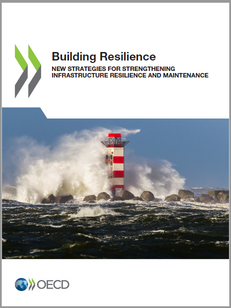Infrastructure resilience and maintenance
Context
Following the COVID-19 shock to economies and societies, many countries are including renewed infrastructure investment as a stimulus measure. Such investments present an opportunity for governments to address short-term infrastructure challenges through maintenance spending while building resilient and sustainable infrastructure for the future. Tackling the complex challenges and opportunities related to infrastructure resilience and maintenance requires a multidimensional approach, considering several factors and stakeholders at the local, regional, national and global levels. This approach seeks to get the best out of the asset over its life cycle, across functions and tasks and the entire infrastructure system/network, leveraging new technologies and nature-based solutions opportunities.
The report
> READ THE FULL REPORT on the OECD Ilibrary
> READ THE BLOG POST
Drawing on examples and case studies, this report aims to provide a framework to optimise existing infrastructure assets and build new resilient infrastructure, including new strategies capable of ensuring quality and performance over the asset life-cycle.
It also aims to support the development of the G20 Policy Agenda on Infrastructure Maintenance presented by the Italian presidency at the G20 Ministries of Finance and Central Banks meeting in July 2021.
For more information about the report, please contact Raffaele Della Croce: Raffaele.DELLACROCE@oecd.org
| WATCH THE REPLAY OF THE COP26 EVENT "Building Infrastructure Resilience and Strenghtening Maintenance" |
Why is this important?
Infrastructure investment is a means, not an end and requires a new systemic approach. Infrastructure investment has the potential to generate long-term benefits to society in terms of inclusive economic growth and improvements to wellbeing; it could contribute to key policy priorities, such as supporting the low-carbon transition, protecting biodiversity, making societies more resilient, addressing disparities across regions and cities, and promoting sustainable development.
Transitioning to low carbon infrastructure. Investments in low-emission infrastructure will require an unprecedented transformation of our infrastructure system. Most existing energy and transport infrastructure was designed and built for a world of cheap and abundant fossil fuels, contributing to economic growth in many regions but also GHG (greenhouse gas) emissions. Choices made on infrastructure systems in the next decade will be critical for achieving net-zero objectives and halting the dramatic loss in biodiversity.
Resilient infrastructure as an economic opportunity. Resilience is essential to absorb the impacts of adverse shocks and it creates a unique opportunity for countries to be ready against future risks as part of their recovery efforts. Private investors also increasingly recognise the business case for sustainability and require assets to meet ESG criteria to manage risks, respond to regulatory requirements and initiatives such as the EU Taxonomy for sustainable activities.
Infrastructure as providing a service to the Community. While serving as a key means to achieve sustainable development, infrastructure needs to consider changing community expectations, the increasing power of civil society and social connectivity, as well as potential new legal requirements, all of which add to the complexity of delivering infrastructure projects effectively. Strong community opposition can result in project delays, cost overruns and cancellations. The lack of an inclusive approach to project planning, design, and delivery is seriously detrimental for companies, investors, and national governments.
New technologies allow the reduction of maintenance costs while improving operational efficiency and offering alternatives to traditional infrastructure design, construction and maintenance. Technology development plays a critical role in responding to the COVID-19 crisis enabling infrastructure to become more resilient to future disasters and ensuring the continued operations of critical networks such as utilities, transport and telecommunications. At the same time, digitalisation comes along with new vulnerabilities to security threats, for instance, which require further thinking around resilience and maintenance.
Nature is an asset for infrastructure sustainability. Green infrastructure development ensures infrastructure itself does not undermine environmental sustainability goals while also ensuring better protection of infrastructure assets and services against the unavoidable impacts of environmental degradation and climate change. Climate change adaptation, including through nature-based solutions, can help countries develop climate-resilient infrastructure that reduces vulnerability and exposure to climate-related risks such as sea level risks or extreme climate events such as storms or floods (OECD, 2018). The COVID-19 crisis has highlighted the interconnections between healthy ecosystems and healthy communities. Fostering, replicating and scaling up Nature-based solutions (NbS), which provide a physically effective and cost-efficient alternative or complement to grey infrastructure solutions, is a key opportunity for strengthening infrastructure sustainability.
Related work and publications
- > T20 (2021), Policy brief on Maintenance and Resilient Infrastructure
- > Coalition for Disaster Resilient Infrastructure-Resilience Shift (2021), Governance of Infrastructure for Resilience
- > G20 (2021) Policy Agenda on Infrastructure Maintenance and Final declaration
- > World Bank/OECD, (2021), A once-in-a-generation opportunity: How green infrastructure saves lives and livelihoods, World Bank Blogs
- > OECD (2021), Implementation Handbook for Quality Infrastructure Investment
- > OECD (2020), Recommendation of the Council on the Governance of Infrastructure
- > G20/OECD (2020), G20/OECD Report on the Collaboration with Institutional Investors and Asset Managers on Infrastructure: Investor Proposals and the Way Forward
- > OECD (2020), OECD Business and Finance Outlook 2020: Sustainable and Resilient Finance, Chapter 7 “ESG and Institutional Investment in Infrastructure”
- > OECD (2020), COVID-19 and a New Resilient Infrastructure Landscape, OECD Policy Response to COVID-19
- > OECD (2019), "Blockchain technologies as a digital enabler for sustainable infrastructure", OECD Environment Policy Papers
- > OECD (2018), "Climate-resilient infrastructure", OECD Environment Policy Papers
- > OECD/The World Bank/UN Environment (2018), Financing Climate Futures: Rethinking Infrastructure
- > OECD (2017), Getting Infrastructure Right: A Framework for better Governance
